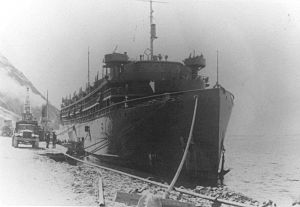 SS Dorchester
| |
| History | |
|---|---|
| Name | Dorchester |
| Namesake | Dorchester, Boston |
| Operator | Merchants and Miners Transportation Company |
| Route | Miami–Boston |
| Builder | Newport News Shipbuilding and Dry Dock Company |
| Yard number | 289 |
| Laid down | September 10, 1925[1] |
| Launched | March 20, 1926[1] |
| Acquired | Delivered July 17, 1926.[2] |
| Name | SS Dorchester (troop transport) |
| Owner | Control: War Shipping Administration |
| Operator | Atlantic, Gulf & West Indies Steamship Lines (Agwilines) |
| Acquired | January 24, 1942 |
| Fate | Torpedoed and sunk by U-223, February 3, 1943 |
| General characteristics | |
| Type | Passenger ship / Troopship |
| Tonnage | 5,649 gross register tons (GRT)[3] |
| Length | 368 ft (112 m)[3] |
| Beam | 52 ft (16 m)[3] |
| Draft | 19 ft (5.8 m)[3] |
| Propulsion | Triple expansion engine[3] |
| Speed | 12 knots (22 km/h; 14 mph)[3] |
| Capacity |
|
| Complement |
|
| Armament |
|
Dorchester was a coastal passenger steamship requisitioned and operated by the War Shipping Administration (WSA) in January 1942 for wartime use as a troop ship allocated to United States Army requirements. The ship was operated for WSA by its agent Atlantic, Gulf & West Indies Steamship Lines (Agwilines). The ship was in convoy SG 19 from New York to Greenland transiting the Labrador Sea when it was torpedoed by a German U-boat on February 3, 1943. The ship sank with loss of 674 of the 904 on board with one of the 230 survivors lost after rescue. The story of four Army chaplains, known as the "Four Chaplains" or the "Immortal Chaplains," who all gave away their life jackets to save others before they died, gained fame and led to many memorials.
